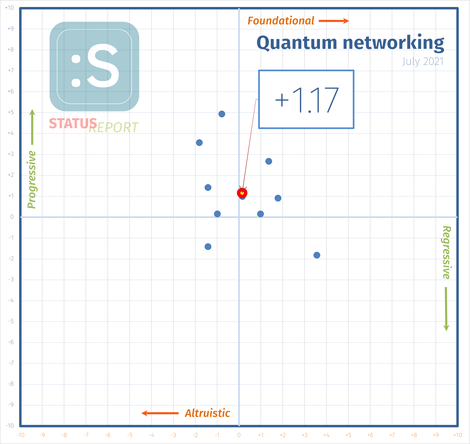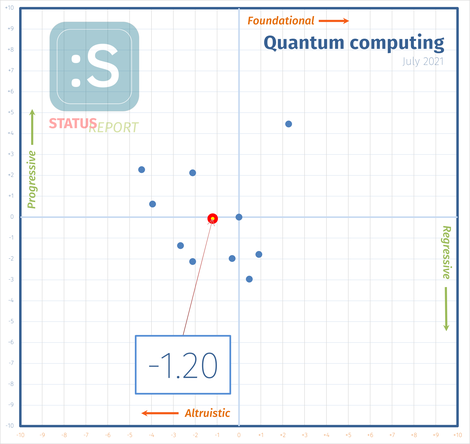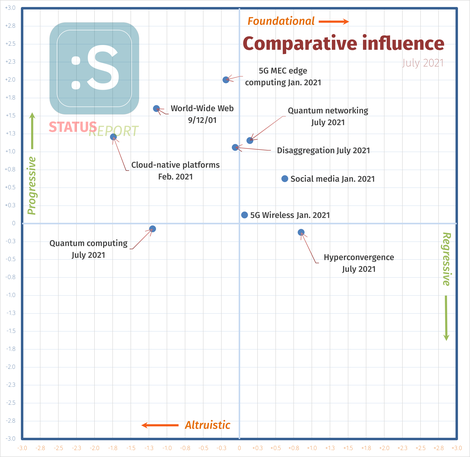Photo of sunrise over New Zealand captured by Astronaut Scott Kelly. Copyright 2015 by NASA, released for public use.
Quantum computing (QC) and quantum networking (QN) are related, though independent, industries. Both leverage the same unexplained phenomenon in quantum physics: the entanglement between particles that enables them to share states — or in the digital sense, information — in apparent violation of relativity theory. But as services, they fulfill separate functions.
QC endeavors to solve problems typically delegated to supercomputers, or that would be so delegated if supercomputers were fast enough to resolve those problems within our lifetimes.
QN would secure connections between digital devices (including the conventional variety — yours and mine) using a physics technique that would be permanently crack-proof. It would rather let the connection crash than allow it to be pilfered.
In a previous Status Report published in March, I came down hard on quantum computing as a viable technology. I had just taken part in a virtual quantum conference where QC and QN were both featured on the same stage. And I came away with a single, conglomerate viewpoint about the two endeavors. If you read my ZDNet colleague Daphne Prince-Ringuet’s thorough, up-to-date coverage, you might wonder from whence my negative attitude about QC sprang forth (not quite iambic pentameter, but I tried).
As some folks have kindly told me, there’s a completely different business model for the first startups and the established cloud players building quantum computers compared with the academics and security professionals experimenting with quantum networks. The latter would, at the very least, revolutionize cybersecurity. At most, it could force a cataclysmic change in the way the entire Internet is operated. If no conventional cryptography can possibly avoid a near-instantaneous crack by a QC system, theoretically, HTTPS as a protocol would become pointless.
With this edition of Status Report, we’ll update our view of QC and add an independent assessment of QN. Here’s how these assessments work: For each topic, we look at 10 categories of influence, rating each of their progressive and regressive potentials on positive-10 and negative-10-point scales, respectively. Then on a 2D Cartesian chart, we give each category its own compass direction or vector, plot the position of each influence point on that vector and compute the geometric average location of all points. The distance of that average point from the dead center is our final influence score.
Executive summary
As is our custom here with Status Report, we’ll start at the end with our general conclusions:
Point #1: You can’t build anything quantum in a vacuum
It’s difficult to overstate the implications of the technology we’re talking about — unless, of course, it all proves to be impossible, in which case we’ll all happily look like fools.
Imagine if a mysterious physical force were unleashed that incinerated all the world’s highways in a few minutes. And if something based on the very same mystery could enable people to pop open little cans, place them on their back porches, and watch them instantaneously and automatically build a high-speed railroad network linking them all to replace the vaporized interstates and autobahns. What I’m actually talking about with respect to QN is not too much less fantastic.
If QC comes to full fruition (an event that is far from certain), conceivably, anyone with access to a quantum computer could decrypt a strongly encrypted communication in mere minutes. Who has access to a quantum computer? Would you believe you do? QC’s first practitioners are making quantum systems available for programming by registered experimenters and researchers, no credentials required, in many cases for free. It’s not easy, by any means, nor does it make much sense to rational people, but QC service (such as it is) is operational.
If QN comes to full fruition (see above), some means of securing communications will become feasible again. But because of the physics principle, QN would leverage any “back door,” such as some government agencies would ask network equipment makers to include, would be entirely impossible to engineer.
What we have here, to paraphrase Strother Martin, is an open, collaborative, academic effort whose success would immediately trigger “failure to communicate” securely by conventional means. The intellectual property value of any digital encryption technology for classical systems would plummet like a spent fuel rod in a core meltdown. What’s more, because the collaborative effort required to build a real QN is so great (consider the scale of the Internet we presently have, like a miniature prototype for the one we’ll need), there would be no way to engineer legal exclusivity or proprietary IP rights for any single participant.
Without cooperation from a broad community of scientists, physicists, and engineers, the QC event (which some have already dubbed “Y2K II”) could happen before the QN event could establish a safety net. Well-meaning engineers are collaborating on a class of encryption called post-quantum cryptography (PQC). This would theoretically consist of encryption using classical computers that would take longer for QC to decrypt than its users would be willing to wait. Should the QN space become gummed up by intellectual property matters and licensing fees, the QC event could take place before QN is capable of securing our safety net, leaving PQC to clean up the burning cinders.
Point #2: If you’re not one of the pre-ordained few, then you owe them
In recent years, the lion’s share of quantum networking research appears to have been conducted by academics and publicly funded research organizations. This group may have made the most progress toward establishing a real QN.
Working against them is the fact that the market is already being perceived as having been subdivided into factions, in advance of, and in anticipation of, the market forces that would shape quantum networking once a service actually becomes viable. What folks in the intellectual property (IP) space know all too well is that it can be much easier to stake a legal claim on something that doesn’t exist than something that does, provided you’re good enough at writing believable science fiction.
As the open-source community experiences first-hand every day, IP is the lifeblood of information-based markets. A typical market where open source reigns supreme is one whose IP value is already low, and premiums would be hard to justify — for example, distributed software deployment. In a market like that where margins are already low, a single-player exerting market dominance with heavy license fees, seeking to restrict the number of market participants through IP enforcement, could end up starving itself of revenue.
No market whose terms are literally principles of quantum physics is a typical market. The working title for the IP we’re talking about here is quantum information technology (QIT). As IP research firm Patinformatics reported last year [PDF], the factions with the strongest QIT patent portfolios to date are:
ChinaNorth American defense contractors, acting collectively.IBM
All of these factions presently behave as though they had altruistic interests at heart. On the other hand, they’re all asserting patents.
Point #3: Oh, great, another harbinger of doom
In an extraordinary testament to the willingness of the digital infrastructure industry to follow its own entrenched behavior patterns no matter the consequences, almost no one has bothered to ask why quantum networks would not render all blockchain transactions immediately vulnerable. Bucking this trend, though still perhaps too quietly, consulting firm Deloitte recently admitted, “If a quantum computer will ever get closer to the 10 minutes mark to derive a private key from its public key, then the Bitcoin blockchain will be inherently broken.”
Put another way: Once a true QC becomes operational, the fact that each blockchain system relies upon a single chain should liquidate its trading value faster than an ice cube on a Portland front porch this summer.
Ransomware was a beautiful thing to happen to the security software industry because viruses were already old, and nobody was afraid of them anymore. (Now we don’t have to watch the same old infomercials at 3 a.m.; there are new ones to help us all fall asleep faster.) One reason PQC is becoming interesting is that it brings tidings of a post-ransomware security industry in a world where ransomware provokes yawns, and viruses are things for which we’ve all been vaccinated. Put another way: It’s hard to sell the value of new security when existing security, well, works. A healthy security industry requires a viable threat.
This leads me to this: If QN presents an effective solution before QC can evolve far enough to pose a strong enough threat, QN might not receive the attention, support, or financial backing it needs to launch a working network. We’ve already witnessed how long it takes for a truly dangerous virus to be taken seriously.
Sphere of influence
Now we look at each category of influence to determine how we reached the conclusions above. We’ll compare QN’s scores to updated scores for QC, given some recent events that are helping tip QC’s momentum more positive.
Stakeholder empowerment


The goals for quantum computing can be a bit fuzzy if you accept the scale of “a bit” as the planet’s size. Quantum networking has a more discrete goal. Sure, it defies the laws of physics as we know them, but you don’t have to explain to customers why if you can demonstrate that they do so and that there’s an immediate benefit to them.
There is absolutely no guarantee that this can happen. Quantum networks need a system of repeaters to close the gaps between entangled qubits. Whether quantum repeaters will be reliable, quite seriously, relies upon researchers to resolve the relatively trifling issue of teleportation. In the QN context, this refers to the relocation of a state retained by one unit of quantum memory to another unit of quantum memory without appearing to traverse the distance between them.
Competitive advantage


If you’re the first commercially funded enterprise to resolve the quantum teleportation mystery, and you use your solution to empower the first generation of quantum repeaters, you may be able to claim some competitive advantage over others in the market — such as the market would be at the time. There’s a tricky balance here: You may be first to market, and that window of opportunity may last a little while. But the support you received to get you that far may insist that you give up the throne after a few quarters and let someone else have a shot.
Business sustainability


Any quantum network services provider with an eye for the long game will require funding from government resources and private funds. Obviously, that wasn’t a bad thing for those who established the Internet. It may be just as good for anyone who manages to successfully assert the critical need for a QN before that need actually does become critical. Working against QN’s pioneers will be a message left behind by the Internet’s founders: It’s the services, not the platform, from which the revenue flows.
Evolutionary incentive


If you believe in the power of quantum computing (keep in mind, QC still registers a negative I-score, so the answer here may yet be “no”), it follows that the need for a quantum network would be as critical to the foundation of the 21st-century global economy as renewable electricity and carbon-neutral transportation.
Working against this incentive is the fact that, like these other massive, world-changing projects, QN will require a huge initial investment. Where can we find the billions in public funds that such an endeavor will require? From the very sources that would dictate such terms as with whom you do business and under which country’s auspices (see: 5G Wireless).
Market enablement


If QN can be established first and foremost as a service that will be vitally necessary for the functioning of global trade and everyday transactions, then a commercial market will form around it naturally because demand will be there. Here’s the problem: If QN is put forth initially as a public service, it will automatically become a commodity.
Too often, the value of a commodity is established by forces outside the control of its market’s participants — before public commerce has a crack at it. Recall, in the early days of the Internet, serious thought was given to mandating every user be given free SSL certificates, and all communications are digitally signed. There’s a bullet we dodged.
Customer value


Suppose a day comes along when every financial transaction you conduct online is exposed to anyone with a QC account. You will need QN to give you and your e-commerce providers the keys you need to conduct business. Credit companies will mandate it. Customer value will be built-in.
Economic contribution


There may be value for QN, over and above simply securing electronic communications. The higher degree of security may provide consumers with the level of fraud protection that would render moot the need for AI routines to oversee transactions and detect anomalies. The higher quality of connectivity could protect voice and data communications from interference, eliminating the need for folks to use voice-enabled instant messaging services when they could simply use the phone. There is harvestable value in a quantum-protected economy.
Societal integration


Here is where things get dicey again: A QN service would require each of us to carry a digital identity in such a well-secured world. Not a single, long string of numbers attached to a card, mind you, but a kind of key — probably a physical device, similar to a Yubikey — with which digital identity is continually negotiated with one’s QN service of choice. Not all countries’ populations are opposed to digital identity, but Americans remain largely opposed. The moment quantum becomes a political issue will be the time we lose what temper we’ve managed to maintain thus far for the public discussion of identity and privacy.
Cultural advancement


The danger lies here. The protests over the belief windmills cause cancer and that 5G towers spread coronavirus (hint: some folks ignore the differences between the former pair of landmarks and the latter pair of ailments) were previews of coming attractions for the world in which governments regulate the spin quanta of electrons hosting our digital identities. Had the Internet itself been something folks on the Internet could vote for or against, someone would have led a misinformation campaign that threatened its very existence. Brexit was a prologue to the quantum identity debate.
Ecosystemic enablement


Compared to the cultural issues, the question of whether the nascent QN industry can build a comfortable ecosystem for itself may seem trivial. Keep in mind, however, that without a strong ecosystem — participants willing to work for each other’s mutual benefit — the whole issue of QN’s value to society and human culture would never garner advocates. . . and thus might never foment opponents.
If QN is to have a chance of securing our digital infrastructure prior to the protests gaining steam, it needs a strong ecosystem of supporting researchers and market participants. Only they can keep the peace.
Final score: QN [+1.17] | QC [-1.20]


The opportunity is before us to build a part of the Internet that it arguably should have had from the beginning if we had known back then how things would turn out. Even if making all this quantum theory into practical reality turns out to be infeasible, we have a clearer picture now of the argument in favor of a semi-attached network exclusively devoted to security as a service.


Indeed, if QN development should fail (and it might), its failure would also be a signal of the larger threat to the classical Internet having subsided — because QC would also fail. If it seems far-fetched to imagine a separate Internet just for exchanging encryption keys, even if it’s just PQC (what would we call it then? “Ex-post-quantum cryptography?”), remember, we already have a separate, private Internet of sorts for tunneling streaming media transmissions, bypassing public trunks.


In a worst-case scenario for quantum services, things could still turn out rosy. It’s actually the best-case scenario for which we’ll need to keep a weather eye.



